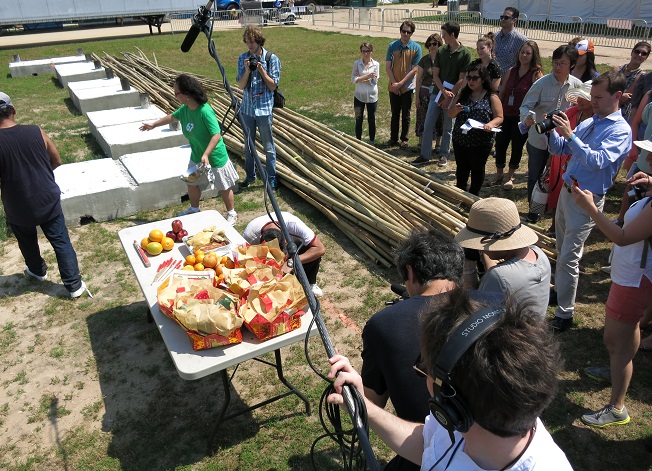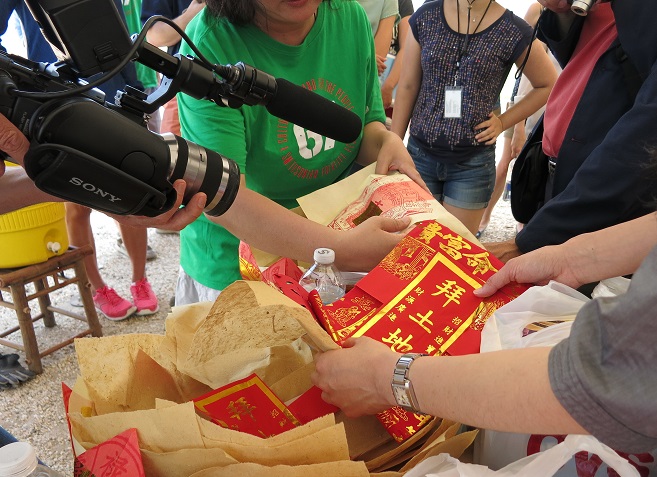Hong Kong Crew Begins Work on Flower Plaque

Not every Smithsonian staff meeting ends in ceremonial fire.
Trust us, it’s an exciting place to work, but Tuesday was a bit more eventful than usual as a weekly Folklife Festival production meeting was followed by a traditional ceremony to ask the blessing of the gods for the construction of the Chinese flower plaque. Smithsonian staff and a group of craftsmen from Hong Kong gathered on the National Mall mid-morning to celebrate the beginning of work on the towering bamboo structure that is being built as part of the China: Tradition and the Art of Living program.
Flower plaques are lightweight, temporary constructions traditionally built in southern China to celebrate occasions such as weddings, rituals, anniversaries, or business openings. It’s an art that fewer and fewer craftsmen practice these days, but a dozen or so artisans in Hong Kong still continue to fashion the versatile plaques out of bamboo, paper, fabric, and other lightweight materials.

The ceremony started with the assembly of bai shen bao (拜神包), stacks of paper that include petitions for good fortune and safety, lucky red paper, fake money, paper clothes, and gold- and silver-ingot-shaped yuan bao (元宝)—all offerings for “the gods or whatever spirits might be on those grounds that need to be appeased,” according to China program advisor Joanna C. Lee.
Lee was an enthusiastic mistress of ceremonies (despite jokingly asking the crowd, “Why am I the priestess here?!”), supervising the setup of a table in the center of the construction site with offerings of tangerines and Asian pears, pork, and a whole chicken with a piece of pig’s tongue in its mouth for good luck. Between switching back and forth between English and Cantonese and bustling about organizing supplies, she explained the finer points of the ritual to spectators: the paper offerings were for the four corners of the building, represented by North, South, East, and West, and would be burned at each corner along with one in the center of the foundation.

Bamboo master and chief craftsman Choi Wing Kei began the ritual by lighting a cluster of incense sticks (also known as joss sticks) and closing his eyes to ask the gods for blessing of the building project. He then led Smithsonian organizers around the perimeter of the foundation, all bowing three times at each corner. Each of the craftsmen also asked for his own blessing and safety with incense and bowing before the table of fruit and offerings.
Aside from the morning’s windy weather, organizing staff battled various other technical difficulties throughout the plaque’s planning process. The 3,000-odd pounds of bamboo and wood were shipped from Hong Kong to Tacoma, Washington, where it spent several days with the U.S. Department of Agriculture before it could be cleared by U.S. Customs. Due to that delay, trucks carrying the two forty-foot sea containers were rushed across the country in time to begin construction.
Michael Atwood Mason, director of the Center for Folklife and Cultural Heritage, was one enthusiastic participant. Besides leading a paper bundle-burning (with mixed success in the face of the wind), it was his job to make the first cut in the chicken and pork offerings and take a bite as workers and staff applauded.

At the end of the ceremony he assumed the job of handing a red envelope of money to each worker, a tradition followed by business leaders in Hong Kong on holidays and special occasions. Each gift was accompanied by calls of “lai lai see see” (from lai see, 利是, the name for the packets), a Cantonese phrase for good fortune. Ordinarily the token might be up to $100 Hong Kong (about $14 U.S.), but for the Smithsonian project, it was a single “Washington” for an auspicious start in D.C.
Meg Boeni is a media intern for the Center for Folklife and Cultural Heritage who studies journalism and Spanish at Boston University. Learn more about Chinese traditions at the China: Tradition and the Art of Living program at the 2014 Folklife Festival.

